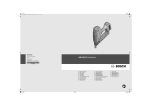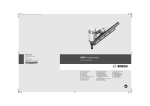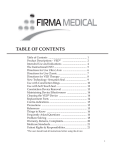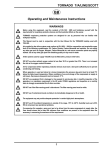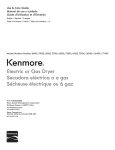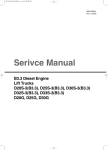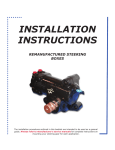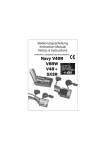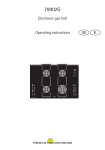Download Bosch GSK 64-34 Professional Product specifications
Transcript
OBJ_BUCH-1302-001.book Page 1 Tuesday, March 22, 2011 11:17 AM Robert Bosch GmbH Power Tools Division 70745 Leinfelden-Echterdingen Germany www.bosch-pt.com GSK 64-34 Professional 1 609 929 X30 (2011.03) PS / 219 UNI de en fr es pt it nl da sv no fi Originalbetriebsanleitung Original instructions Notice originale Manual original Manual original Istruzioni originali Oorspronkelijke gebruiksaanwijzing Original brugsanvisning Bruksanvisning i original Original driftsinstruks Alkuperäiset ohjeet el tr pl cs sk hu ru uk ro bg sr Ðñùôüôõðï ïäçãéþí ÷ñÞóçò Orijinal işletme talimat Instrukcja oryginalna Původní návod k používání Pôvodný návod na použitie Eredeti használati utasítás Îðèãèíàëüíîå ðóêîâîäñòâî ïî ýêñïëóàòàöèè Îðèã³íàëüíà ³íñòðóêö³ÿ ç åêñïëóàòàö³¿ Instrucţiuni originale Îðèãèíàëíà èíñòðóêöèÿ Originalno uputstvo za rad sl hr et lv lt ar fa Izvirna navodila Originalne upute za rad Algupärane kasutusjuhend Instrukcijas oriģinālvalodā Originali instrukcija ΔϴϠλϷ ϞϴϐθΘϟ ΕΎϤϴϠόΗ ̶Ϡλ έΎ̯ ίήσ ̵ΎϤϨϫέ OBJ_BUCH-1302-001.book Page 3 Tuesday, March 22, 2011 11:17 AM |3 4 5 6 7 8 9 10 3 2 1 13 12 GSK 64-34 Professional 11 A 15 8 14 Bosch Power Tools 1 609 929 X30 | (22.3.11) OBJ_BUCH-1302-001.book Page 4 Tuesday, March 22, 2011 11:17 AM 4| B1 B2 16 10 maximum 17 B3 B4 18 18 10 11 11 10 C 6 5 1 609 929 X30 | (22.3.11) Bosch Power Tools OBJ_BUCH-1302-001.book Page 5 Tuesday, March 22, 2011 11:17 AM |5 D 6 5 E1 E2 18 11 10 17 F 12 Bosch Power Tools 12 1 609 929 X30 | (22.3.11) OBJ_BUCH-1302-001.book Page 6 Tuesday, March 22, 2011 11:17 AM 6| G1 G2 19 3 G3 H 9 2 1 3 I J 8 4 1 609 929 X30 | (22.3.11) Bosch Power Tools OBJ_BUCH-1302-001.book Page 15 Tuesday, March 22, 2011 11:17 AM English | 15 English Safety Notes General Safety Rules for Pneumatic Tools fRemove any adjustment tools before switching on the pneumatic tool. A wrench or key left attached to a rotating part of a pneumatic tool may result in personal injury. fDo not overreach. Keep proper footing and balance at all times. This enables better control of the pneumatic tool in unexpected situations. Read and observe all safety warnings and instructions. Failure to follow the following safety warnings and instructions may result in electric shock, fire and/or serious injury. fDress properly. Do not wear loose clothing or jewellery. Keep your hair, clothing and gloves away from moving parts. Loose clothes, jewellery or long hair can be caught in moving parts. Save all warnings and instructions for future reference. fIf devices are provided for the connection of dust extraction and collection facilities, ensure these are connected and properly used. Use of dust collection can reduce dust-related hazards. WARNING Work area safety fKeep work area clean and well lit. Cluttered or dark areas invite accidents. fDo not operate the pneumatic tool in explosive atmospheres, such as in the presence of flammable liquids, gases or dusts. While working the workpiece, sparks can be created which may ignite the dust or fumes. fKeep children and bystanders away from your workplace while operating the pneumatic tool. Distractions from other persons can cause you to lose control over the pneumatic tool. Pneumatic tool safety fUse compressed air of Quality Class 5 in accordance with DIN ISO 8573-1 and a separate maintenance unit close to the pneumatic tool. The compressed air supplied should be free of foreign material and moisture to protect the pneumatic tool from damage, contamination, and the formation of rust. fCheck the connections and the air supply lines. All maintenance units, couplers, and hoses should conform to the product specifications in terms of pressure and air volume. Too low pressure impairs the function of the pneumatic tool; too high pressure can result in material damage and personal injury. fProtect the hoses from kinks, restrictions, solvents, and sharp edges. Keep the hoses away from heat, oil, and rotating parts. Immediately replace a damaged hose. A defective air supply line may result in a wild compressed-air hose and can cause personal injury. Raised dust or chips may cause serious eye injury. fMake sure that hose clamps are always tightened firmly. Loose or damaged hose clamps may result in uncontrolled air escape. Personal safety fStay alert, watch what you are doing, and use common sense when operating a pneumatic tool. Do not use a pneumatic tool while tired or under the influence of drugs, alcohol, or medication. A moment of inattention while operating a pneumatic tool may result in personal injury. fUse personal protective equipment. Always wear eye protection. Protective equipment such as dust mask, non-skid safety shoes, hard hat, or hearing protection used for appropriate conditions will reduce personal injuries. fDo not directly inhale the exhaust air. Avoid exposing the eyes to exhaust air. The pneumatic tool’s exhaust air can contain water, oil, metal particles and debris from the compressor. This can cause damage to one‘s health. Pneumatic tool use and care fUse the clamping devices or a vice to secure and support the workpiece. Holding the workpiece by hand or against your body will not allow for safe operation of the pneumatic tool. fDo not overload the pneumatic tool. Use the pneumatic tool intended for your work. The correct pneumatic tool will do the job better and safer at the rate for which it is designed. fDo not use a pneumatic tool that has a defective On/Off switch. A pneumatic tool that cannot be controlled with the switch is dangerous and must be repaired. fDisconnect the air supply before making any adjustments, changing accessories, or placing the pneumatic tool aside. This safety measure prevents accidental starting of the pneumatic tool. fStore idle pneumatic tools out of the reach of children. Do not allow persons unfamiliar with the pneumatic tool or these instructions to operate the device. Pneumatic tools are dangerous in the hands of untrained users. fMaintain the pneumatic tool with care. Check for misalignment or binding of moving parts, breakage of parts and any other condition that may affect the pneumatic tool’s operation. Have damaged parts repaired before using the pneumatic tool. Many accidents are caused by poorly maintained pneumatic tools. fUse the pneumatic tool, accessories, application tools, etc. according to these instructions. Take into consideration the working conditions and the activities to be carried out. Use of the pneumatic tool for operations different from those intended could result in hazardous situations. Service fHave your pneumatic tool repaired only through a qualified repair person and only using original replacement parts. This will ensure that the safety of the pneumatic tool is maintained. fPrevent unintentional starting. Make sure that the pneumatic tool is switched off before connecting it to the air supply, picking it up or carrying it. When your finger is on the On/Off switch while carrying the pneumatic tool or when connecting the pneumatic tool to the air supply while it is switched on, accidents can occur. Bosch Power Tools 1 609 929 X30 | (22.3.11) OBJ_BUCH-1302-001.book Page 16 Tuesday, March 22, 2011 11:17 AM 16 | English Safety Warnings for Compressed-air Nailers/Staplers Wear safety goggles. fAlways assume that the pneumatic tool is loaded with fasteners. Careless handling of the pneumatic tool can lead to unexpected shot actuation of fasteners and cause injury. fWhen working, hold the pneumatic tool in such a manner that your head and body cannot be injured in case of sudden kickback due to a malfunction of the energy supply or from hard objects/locations in the workpiece. fNever point the pneumatic tool at yourself or at persons close by. Unexpected actuation will expel a fastener, which can lead to injury. fDo not actuate the pneumatic tool until firmly placed against the workpiece. When the pneumatic tool is not in contact with the workpiece, the fastener can bounce away from the fastening point and overload the pneumatic tool. Do not work on ladders or scaffolds when the actuation system “Contact actuation” is set. In particular, do not move from one fastening location to another, close boxes or enclosures, or fasten transport-securing fixtures on e.g., vehicles and waggons, via scaffolds, stairs, ladders or ladder-like constructions, such as roof battens. With this actuation system, a fastener will be discharged each time when accidentally applying the pneumatic tool while the discharge lock-off is pressed in. This can lead to injury. fObserve the conditions of the job site. It is possible that fasteners can burst through thin workpieces or be deflected when working in corners or against edges, and harm persons. Disconnect the air supply, when the fastener is jammed in the pneumatic tool. When the pneumatic tool is still connected to the power supply, it can accidentally be actuated when removing a jammed fastener. fUse caution when removing a jammed or stuck fastener. The system can be under tension and cause the fastener to be shot or thrust out, while attempting to clear the jam. fDo not use this to pneumatic tool to fasten electrical wiring. It is not suitable for fastening electrical wiring, can damage the insulation of electric cables and thus lead to electric shock and danger of fire. fNever use oxygen or flammable gases as the energy source for the pneumatic tool. Flammable gases are dangerous and can cause the pneumatic tool to explode. fUse appropriate detectors to determine if utility lines are hidden in the work area or call the local utility company for assistance. Contact with electric lines can lead to fire and electric shock. Damaging a gas line can lead to explosion. Penetrating a water line causes property damage or may cause an electric shock. fThe pneumatic tool may only be connected to lines, for which the maximal permissible pressure of the pneumatic tool cannot be exceeded by more than 10 %; for higher pressures, a pressure control valve (pressure reducer) with preceding pressure-limitation valve in the compressed-air line must be installed. Excessive pressure leads to abnormal operation or breakage of the pneumatic tool, which can lead to injury. 1 609 929 X30 | (22.3.11) Product Description and Specifications Read all safety warnings and all instructions. Failure to follow the warnings and instructions may result in electric shock, fire and/or serious injury. Intended Use The pneumatic tool is intended for connecting work in roofing, encasing, battening, manufacturing wall and ceiling elements, wood facades, pallets, wood fences, noise-reduction walls and boxes. Only the fasteners (nails, staples, etc.) specified in table “Technical Data” may be used. Product Features The numbering of the product features refers to the illustration of the pneumatic tool on the graphics page. 1 Workpiece protector 2 Discharge lock-off 3 Clamping lever for opening/closing the shot duct 4 Air outlet with adjustable exhaust cap 5 Trigger 6 Selector switch for actuation system 7 Handle 8 Air connector 9 Storage for workpiece protector 10 Magazine 11 Magazine slider 12 Thumbwheel for depth stop adjustment 13 Outlet 14 Air-connection coupling 15 Supply-air hose 16 Nail strip* 17 Magazine spring 18 Nail pusher 19 Driver blade *Accessories shown or described are not part of the standard delivery scope of the product. A complete overview of accessories can be found in our accessories program. Technical Data Compressed-air nailer Article number Driving force at 6.3 bar (91 psi) Actuation systems – Single actuation with safety run – Contact actuation Fastener – Type – Length – Diameter Magazine angle Magazine capacity, max. Engine oil SAE 10, SAE 20 Internal volume GSK 64-34 Professional 3 601 D91 902 Nm 34.4 z z mm mm ° ml ml Nail strip Brads 32 – 63 1.8 34 100 0.25 – 0.5 330 Bosch Power Tools OBJ_BUCH-1302-001.book Page 17 Tuesday, March 22, 2011 11:17 AM English | 17 Compressed-air nailer Rated pressure Connecting thread Supply-air hose – Max. operating pressure at 20 °C – Inner diameter of hose – Max. hose length Air consumption per driving procedure at 6.8 bar (100 psi) Dimensions – Height – Width – Length Weight according to EPTA-Procedure 01/2003 bar " GSK 64-34 Professional 4–8 3/8 bar " m 10 3/8 30 l 1.46 mm mm mm 307 79 320 kg 1.86 Noise/Vibration Information Measured noise values determined according to EN 12549. Typically the A-weighted noise levels of the pneumatic tool are: Sound pressure level 102 dB(A); sound power level 115 dB(A). Uncertainty K=2 dB. Wear hearing protection! Overall vibrational values determined according to EN ISO 20643: Vibrational emission value ah <2.5 m/s2. Uncertainty K =1.5 m/s2. Declaration of Conformity We declare under our sole responsibility that the product described under “Technical data” is in conformity with the following standards or standardization documents: EN 792 according to the provisions of the directives 2006/42/EC. Technical file at: Robert Bosch GmbH, PT/ESC, D-70745 Leinfelden-Echterdingen Dr. Egbert Schneider Senior Vice President Engineering Dr. Eckerhard Strötgen Head of Product Certification Robert Bosch GmbH, Power Tools Division D-70745 Leinfelden-Echterdingen Leinfelden, 22.03.2011 Assembly Connecting the Air Supply (see figure A) Make sure that the pressure of the compressed-air system is below the maximum permitted rated pressure of the pneumatic tool. Firstly, set the air pressure to the lower value of the recommended rated pressure (see “Technical Data”). When in doubt, check the pressure at the air inlet with a pressure gauge with the pneumatic tool switched on. For maximum performance, the values for the supply-air hose 15 (connection thread, maximum operating pressure, inner hose diameter, maximum hose length; see “Technical Data”) must be observed. Bosch Power Tools The compressed air supplied should be free of foreign material and moisture to protect the tool from damage, contamination, and the formation of rust. All fittings, connecting lines and hoses must be dimensioned for the pressure and the required air volume. Avoid restrictions in the air supply, e.g., from pinching, kinking, or stretching! Connecting the Air Supply to the Pneumatic Tool – Empty the magazine 10. (See “Emptying the Magazine”, page 18) For the following worksteps, a fastener can be discharged when interior parts of the pneumatic tool are not in the starting position due to repairs, maintenance or transport. – Connect the air connector 8 with a supply-air hose 15 equipped with an air-connection coupling 14. – Check the proper function by placing the outlet 13 or the rubber workpiece protector 1 of the pneumatic tool onto a piece of scrap wood or wood material, and discharging once or twice. Loading the Magazine (see figures B1 – B4) Disconnect the air supply before making any adjustments, changing accessories, or placing the pneumatic tool aside. This safety measure prevents accidental starting of the pneumatic tool. fUse only original Bosch accessories (see “Technical Data”). The precision parts of the pneumatic tool such as the magazine, the outlet and the shot duct are matched to Bosch staples, nails and brads. Other manufacturers use other steel qualities and sizes. Using fasteners not permitted, can damage the pneumatic tool and cause injuries. While loading the magazine, hold the pneumatic tool in such a manner that the outlet 13 is not pointed at your own body or at other persons. – Clean and lubricate the magazine slider 11 as required and make sure that the magazine 10 is not dirty/soiled. – Insert a fitting nail strip 16 in the T-slot at the end of the magazine 10. When doing this, the nail tips must be inserted first. – Push the nail strip in the magazine toward the front until the last nail is positioned in front of the magazine spring 17. Note: A lock function of the magazine slider prevents the pneumatic tool from being started with an empty magazine. The discharge lock-off cannot be pressed in and blank firing is thus prevented. – Press the pretensioned nail pusher 18 against the magazine slider 11 and at the same time, pull the magazine slider completely to the end of the magazine 10. Note: The magazine slider must slide back with only low force (fingerpressure). A tight-running magazine slider causes the nails to be driven in at an incorrect angle. – With the nail pusher 18 pressed, carefully guide the magazine slider 11 toward the front until the nail pusher is over the last nail, thus pushing the nail strip in the magazine completely to the front. Note: Do not let the magazine slider snap back without guiding it. Otherwise, the magazine slider could become damaged, and there is danger of your fingers being caught or pinched. 1 609 929 X30 | (22.3.11) OBJ_BUCH-1302-001.book Page 18 Tuesday, March 22, 2011 11:17 AM 18 | English Operation Working Advice Disconnect the air supply before making any adjustments, changing accessories, or placing the pneumatic tool aside. This safety measure prevents accidental starting of the pneumatic tool. Actuation systems The pneumatic tool can be operated with two different actuations systems: – Single actuation with safety run With this actuation system, the discharge lock-off 2 must first be firmly pressed against the workpiece. A fastener is not discharged until the trigger 5 is pulled. Afterwards, further discharging procedures can only be actuated, when the trigger and the discharge lock-off have first been set back to the starting position. – Contact actuation With this actuation system, the trigger 5 must be pulled first. A fastener is always discharged when the discharge lock-off 2 is firmly pressed against the workpiece while the trigger is pressed. This enables a higher working speed to be achieved. The actuation system is set via the selector switch 6. Starting Operation Disconnect the air supply before making any adjustments, changing accessories, or placing the pneumatic tool aside. This safety measure prevents accidental starting of the pneumatic tool. Working with Single Actuation (see figure C) – Press selector switch 6 inward and at the same time pivot it to the bottom position until it engages. The actuation system “single actuation” is set. – Firmly position the outlet 13 or the rubber workpiece protector 1 on the workpiece until discharge lock-off 2 is pressed in completely. – Afterwards, briefly press trigger 5 and release again. A nail is discharged. – Allow the pneumatic tool to bounce back from the workpiece. – For another driving procedure, completely lift the pneumatic tool from the workpiece and position it firmly at the next desired location. Check the proper function of the safety and actuation devices, and the tight seating of all screws and nuts each time before using. Disconnect a defective or not properly operating pneumatic tool immediately from of the air supply and contact an authorised service agent for Bosch power tools. Do not perform any incorrect manipulations on the pneumatic tool. Do not disassemble or block any components of the pneumatic tool, such as the discharge lock-off. Do not carry out “emergency repairs” with unsuitable means. The pneumatic tool is to be maintained regularly and properly (see “Maintenance and Cleaning”, page 19). Avoid any weakening and damage whatsoever of the pneumatic tool, e.g., through: – – – – – – Imprinting or engraving, Retrofitting measures not approved by the manufacturer, Guiding along templates manufactured of hard material, e.g. steel, Dropping on or sliding over the floor, Using as a hammer, Applying any kind of force. Make sure to check whatever is below or behind your workpiece. Do not shoot nails into walls, ceilings or floors, when persons are behind them. The nails can burst through the workpiece and injure someone. Do not shoot a nail onto an already driven-in one. This could cause the nail to deform, the nails could become jammed or the pneumatic tool could move uncontrolled. When the pneumatic tool is used under cold ambient conditions, the first nails will be driven in slower than usual. Once the pneumatic tool has warmed up during working, normal operating speed will be regained. Avoid blank shots in order to reduce the wear of the impact striker. For longer work breaks or after finishing work, disconnect the pneumatic tool from the air supply and empty the magazine. Working with Contact Actuation (see figure D) Emptying the Magazine (see figures E1 – E2) – Press selector switch 6 inward and at the same time pivot it to the upper position until it engages. The actuation system “contact actuation” is set. – With the nail pusher 18 pressed, pull the magazine slider 11 to the rear until the last nail is free; then carefully guide the magazine slider toward the front to the beginning of the magazine 10. – Press and hold the trigger 5. – Firmly position the outlet 13 or the rubber workpiece protector 1 on the workpiece until discharge lock-off 2 is pressed in completely. A nail is discharged. – Allow the pneumatic tool to bounce back from the workpiece. – For another driving procedure, completely lift the pneumatic tool from the workpiece and position it firmly at the next desired location. – Move the pneumatic tool uniformly over the workpiece by lifting it off and applying it again. Each time when applying the pneumatic tool while the discharge lockoff is pressed in, a nail will be discharged. – As soon as the desired amount of nails have been driven in, release trigger 5 again. 1 609 929 X30 | (22.3.11) Note: Do not let the magazine slider snap back without guiding it. Otherwise, the magazine slider could become damaged, and there is danger of your fingers being caught or pinched. – Turn the pneumatic tool so that the nails in the magazine slide back to the magazine spring 17. – Push the magazine spring down and allow the nails to slide past the nail pusher 18 out of the magazine 10. Adjusting the Depth Stop (see figure F) The driving depth of the nails can be set with thumbwheel 12. – Empty the magazine 10. (See “Emptying the Magazine”, page 18) – Nails are driven in too deeply: To reduce the driving depth, turn thumbwheel 12 in anticlockwise direction. or Bosch Power Tools OBJ_BUCH-1302-001.book Page 19 Tuesday, March 22, 2011 11:17 AM English | 19 Nails are not driven in deep enough: To increase the driving depth, turn thumbwheel 12 in clockwise direction. – Refill the magazine. (See “Loading the Magazine”, page 17) – Test the new driving depth on a test workpiece. Repeat the worksteps as required. Transport and Storage Removing the Discharge Lock-off When not using the pneumatic tool for a longer period of time, cover steel parts with a fine oil coating. This prevents the formation of rust. For service or cleaning purposes, the discharge lock-off 2 can be removed. – Turn thumbwheel 12 in clockwise direction, until the first thread can be seen. – Carry out 6 further turns in clockwise direction. The discharge lock-off 2 can now be pulled off. – To reinsert again, slide discharge lock-off 2 back into the holes intended for this, and turn thumbwheel 12 in anticlockwise direction until no more threads can be seen. Clearing Jams (see figures G1 – G3) Single nails can become jammed in the shot duct. If this should occur frequently, please contact an authorised service agent for Bosch power tools. – Empty the magazine 10. (See “Emptying the Magazine”, page 18) – Press clamping lever 3 down so that the shot duct opens. – Remove the jammed nail. For this, us a pair of pliers, if required. – When driver blade 19 is extended, push it back into the piston using a lubricated screwdriver or other suitable lubricated object. – Lubricate the shot duct with 2 – 3 drops of engine oil (SAE 10 or SAE 20). – Close the shot duct, hang the clip of clamping lever 3 into the hooks on the shot duct and then push the clamping lever up again. – Refill the magazine. (See “Loading the Magazine”, page 17) For transport, disconnect the pneumatic tool from the air supply; especially when using ladders or moving in an unusual stance or posture. At the workplace, carry the pneumatic tool only by the handle 7 and with the trigger 5 released. Always store the pneumatic tool disconnected from the air supply and at a clean and dry location. Maintenance and Service Maintenance and Cleaning Disconnect the air supply before making any adjustments, changing accessories, or placing the pneumatic tool aside. This safety measure prevents accidental starting of the pneumatic tool. If the pneumatic tool should fail despite the care taken in manufacture and testing, repair should be carried out by an authorised customer services agent for Bosch power tools. In all correspondence and spare parts orders, please always include the 10-digit article number given on the type plate of the pneumatic tool. fHave maintenance and repair work carried out only through qualified persons. This will ensure that the safety of the pneumatic tool is maintained. An authorized Bosch after-sales service agent will carry out this work quickly and reliably. Lubricating the Pneumatic Tool (see figure J) When the pneumatic tool is not connected to a maintenance unit, it must be lubricated at regular intervals: – For light-duty use 1x per day. – For heavy-duty use 2x per day. Note: When the driver blade does not return after clearing a jam, please contact an authorised service agent for Bosch power tools. Apply 2 – 3 drops of lubricant into air connector 8. Do not apply too much lubricant, which could then accumulate in the pneumatic tool and be emitted via air outlet 4. Changing the Workpiece Protector (see figure H) Use only the lubricants recommended by Bosch. The workpiece protector 1 at the end of the discharge lock-off 2 protects the workpiece until the pneumatic tool is correctly placed for the driving procedure. – SAE 10 mineral engine oil (for use at very cold ambient conditions) – SAE 20 mineral engine oil The workpiece protector can be removed and replaced. Observe all applicable environmental regulations when disposing of old grease and solvents. – Pull the workpiece protector from the discharge lock-off. – Push the new workpiece protector via the open end over the discharge lock-off. Note: A spare workpiece protector can be stored at the top side of magazine 10. For this, push the workpiece protector into the depot 9. Adjustable Air-outlet cap (see figure I) With the adjustable exhaust cap at the air outlet 4, it is possible to deflect the exhaust air away from yourself or the workpiece. Bosch Power Tools 1 609 929 X30 | (22.3.11) OBJ_BUCH-1302-001.book Page 20 Tuesday, March 22, 2011 11:17 AM 20 | English Maintenance Schedule Always keep air outlet 4, discharge lock-off 2 and trigger 5 clean and free of foreign material (dust, chips, sand, etc). Clean the magazine 10. Remove any plastic or wood chips that may accumulate in the magazine during operation. Clean the pneumatic tool in regular intervals using compressed air. Measure Draining the exhaust filter daily. Explanation Prevents the accumulation of dirt/ debris and moisture in the pneumatic tool. Ensures the lubrication of the pneumatic tool. Action – Open the drain valve. – Fill lubricator with the recommended lubricants. (See “Lubricating the Pneumatic Tool”, page 19) – Blow out the mechanism of the Cleaning the magazine 10 and magazine slider Prevents the jamming of nails. magazine/magazine slider daily with com11. pressed air. Ensuring that the discharge lock-off 2 functions Promotes your work safety and efficient usage of – Blow out the mechanism of the discharge lockthe pneumatic tool. off daily with compressed air. properly. Reduces the wear of the pneumatic tool. – Apply 2 – 3 drops of lubricant into air connecLubricating the pneumatic tool. tor 8. (See “Lubricating the Pneumatic Tool”, page 19) Prevents the accumulation of dirt/ debris and – Open the drain valve of the compressor tank. Draining the compressor. moisture in the pneumatic tool. Keeping the lubricator filled at all times. Correction of Malfunctions Problem Cause The pneumatic tool is ready for operation A nail is jammed in the shot duct. but no nails are discharged. The magazine slider is 11 defective. Corrective Measure – Clear the jam. (See “Clearing Jams”, page 19) – Clean and lubricate the magazine slider 11 as required and make sure that the magazine 10 is not dirty/soiled. The spring of the magazine slider is too week or de- – Contact an authorised service agent for Bosch fective. power tools. Have the component replaced there. The fasteners being used are not permitted. – Use only original accessories. Only the fasteners (nails, staples, etc.) specified in table “Technical Data” may be used. The magazine 10 is empty. – Refill the magazine. (See “Loading the Magazine”, page 17) The nails are discharged very slowly and The rated pressure of the compressed-air supply is – Increase the compressed-air supply. 8 bar may too low. not be exceeded. with too little pressure. The driver blade is damaged. – Use only the lubricants recommended by Bosch. (See “Lubricating the Pneumatic Tool”, page 19) The sealing ring of the piston is worn or damaged. – Contact an authorised service agent for Bosch power tools. Have the component replaced there. The buffer is worn. – Contact an authorised service agent for Bosch power tools. Have the component replaced there. The length and diameter of supply-air hose 15 do not – Use a supply-air hose with the correct dimensions. correspond with the data of this pneumatic tool. (See “Technical Data”, page 16) The supply-air hose 15 is bent/creased. – Correct the bend/crease in the supply-air hose. 1 609 929 X30 | (22.3.11) Bosch Power Tools OBJ_BUCH-1302-001.book Page 21 Tuesday, March 22, 2011 11:17 AM English | 21 Problem The nails are driven in too deep. Cause The rated pressure of the compressed-air supply is too high. The depth stop is set too deep. Corrective Measure – Reduce the compressed-air supply. 4 bar may not be fallen below. – Adjust the depth stop to the desired depth. (See “Adjusting the Depth Stop”, page 18) The buffer is worn. – Contact an authorised service agent for Bosch power tools. Have the component replaced there. The nails are not driven in deep enough. The rated pressure of the compressed-air supply is – Increase the compressed-air supply. 8 bar may too low. not be exceeded. The depth stop is set too high. – Adjust the depth stop to the desired depth. (See “Adjusting the Depth Stop”, page 18) The length and diameter of supply-air hose 15 do not – Use a supply-air hose with the correct dimensions. correspond with the data of this pneumatic tool. (See “Technical Data”, page 16) The supply-air hose 15 is bent/creased. – Correct the bend/crease in the supply-air hose. – Use only original accessories. The pneumatic tool skips nails or has a The fasteners being used are not permitted. Only the fasteners (nails, staples, etc.) specified too large cycle feed. in table “Technical Data” may be used. The magazine 10 is not operating correctly. – Clean and lubricate the magazine slider 11 as required and make sure that the magazine 10 is not dirty/soiled. The spring of the magazine slider is too week or de- – Contact an authorised service agent for Bosch fective. power tools. Have the component replaced there. The sealing ring of the piston is worn or damaged. – Contact an authorised service agent for Bosch power tools. Have the component replaced there. The fasteners being used are not permitted. – Use only original accessories. Frequent jamming of nails in the shot Only the fasteners (nails, staples, etc.) specified duct. in table “Technical Data” may be used. – Contact an authorised service agent for Bosch power tools. The driver blade is damaged. – Contact an authorised service agent for Bosch The driven nails are bent. power tools. Have the component replaced there. – Use a supply-air hose with the correct dimensions. Contrary to working with normal operat- The interior diameter of the supply-air hose is too low. (See “Technical Data”, page 16) ing speed, the nails are not driven in deep enough at higher operating speed. The compressor is not suitable for fast operating – Use a compressor that is sufficiently dimensioned speeds. for the number of connected pneumatic tools and the operating speed. Accessories Great Britain For more information on the complete quality accessories program, please refer to the Internet under www.bosch-pt.com or contact your specialist shop. Robert Bosch Ltd. (B.S.C.) P.O. Box 98 Broadwater Park North Orbital Road Denham Uxbridge UB 9 5HJ Tel. Service: +44 (0844) 736 0109 Fax: +44 (0844) 736 0146 E-Mail: [email protected] After-sales Service and Customer Assistance Our after-sales service responds to your questions concerning maintenance and repair of your product as well as spare parts. Exploded views and information on spare parts can also be found under: www.bosch-pt.com Our customer service representatives can answer your questions concerning possible applications and adjustment of products and accessories. Bosch Power Tools 1 609 929 X30 | (22.3.11)












